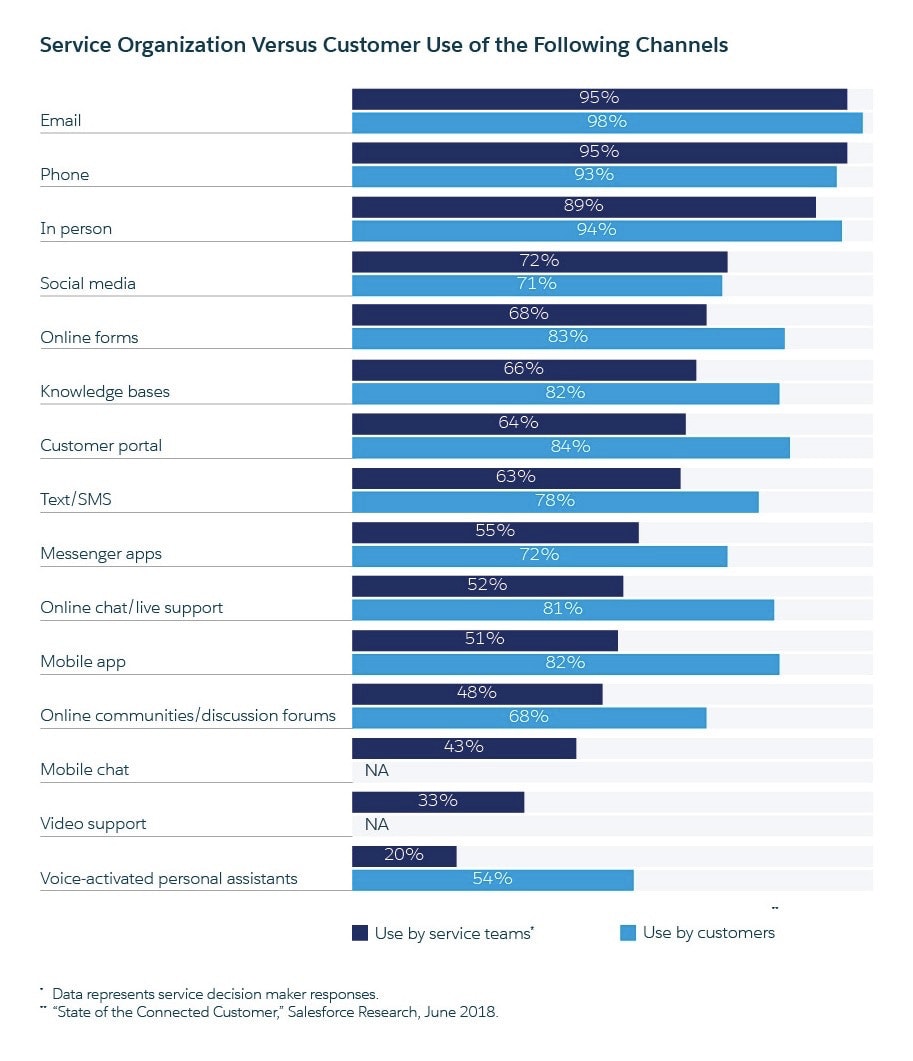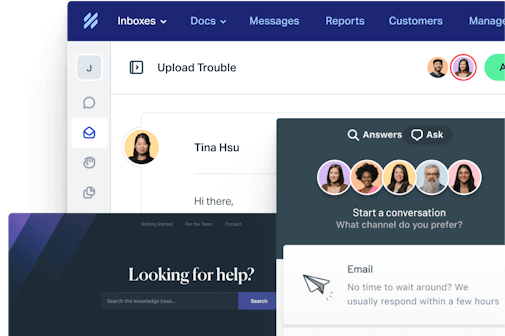Your customer experience is the main differentiator between you and your competitors, and all of the customer service statistics back it up.
Below, we’ve collected 107 key statistics exploring the relevance and importance of good customer service — and expanding on the cost and impacts of poor customer service.
Rather than view these statistics in a vacuum, layer them over your own experiences and the services you are currently offering. There’s a little something in the following chapters for everyone — whether you’re new and just trying to chart the way for your team or have been doing it for years.
The ROI of great customer service
“We see our customers as invited guests to a party, and we are the hosts. It’s our job every day to make every important aspect of the customer experience a little bit better.” –Jeff Bezos
Everyone wants to be known for providing excellent customer service. Not only does it feel good to be helpful, but it is a key differentiator, as the following customer service statistics show.
Customer service, when done well, has just as much impact as a strong sales funnel or excellent marketing efforts. Not only that, but if your customer service team does a fantastic job, it may help boost your other teams’ effectiveness.
It’s easier to make a sale when your customers feel supported, and word-of-mouth marketing after an extraordinary experience is one of the best pitches on the market.
Not convinced? Here are a few customer service statistics that serve to emphasize just how paramount excellent customer service can be for your bottom line:
68% of consumers say they are willing to pay more for products and services from a brand known to offer good customer service experiences. (HubSpot)
For 86%, good customer service turns one-time clients into long-term brand champions. (Khoros)
An NPS Promoter score has a customer lifetime value that's 600%-1,400% higher than a Detractor. (Bain & Company)
89% of consumers are more likely to make another purchase after a positive customer service experience. (Salesforce Research)
93% of customers are likely to make repeat purchases with companies who offer excellent customer service. (HubSpot Research)
If the company’s customer service is excellent, 78% of consumers will do business with them again after a mistake. (Salesforce Research)
Increasing customer retention rates by just 5% can increase profits by between 25% and 95%. (Bain and Company)
Nearly three out of five consumers report that good customer service is vital for them to feel loyalty toward a brand. (Zendesk)
A good customer service experience heavily impacts recommendations. Consumers who rate a company’s service as “good” are 38% more likely to recommend that company. (Qualtrics XM Institute)
Investing in new customers is between 5 and 25 times more expensive than retaining existing ones. (Invesp)
83% of customers agree that they feel more loyal to brands that respond and resolve their complaints. (Khoros)
Businesses can grow revenues between 4% and 8% above their market when prioritizing better customer service experiences. (Bain & Company)
80% of companies use customer satisfaction scores to analyze customer experience and improve it. (Harvard Business Review)
72% of companies believe they can use analytics reports to improve the customer experience. (Deloitte)
The customer experience management market worldwide is worth as much as $7.6 billion in 2020. This is a 16.9% year-over-year increase from its value of $6.5 billion in 2019. (Grand View Research)
As you can tell, excellent customer service is a name maker, no matter what your industry. It helps grow revenue, maintain customer loyalty, and improve your overall business strategy.
Key customer insights like customer satisfaction score and NPS help your customer service team improve and grow their impact. Beyond that, though, they also help your other customer-facing teams understand where they could be making improvements. Who wouldn’t want to give everyone else a leg up?
The cost of bad customer service
Now that we know how important good customer service can be for your business, it’s time to get a handle on the impact it can have when things go badly.
Just like good customer service leads to your team’s success, poor customer service sets them back. A good experience means that customers are much more inclined to go easy if another experience goes awry. The following customer service statistics help to illustrate this:
It takes 12 positive customer experiences to make up for one negative experience. (Ruby Newell-Legner’s "Understanding Customers")
65% of customers said they have changed to a different brand because of a poor experience. (Khoros)
After more than one bad experience, around 80% of consumers say they would rather do business with a competitor. (Zendesk)
Only one in five consumers will forgive a bad experience at a company whose customer service they rate as “very poor.” (Nearly 80% will forgive a bad experience if they rate the service team as “very good.”) (Qualtrics XM Institute)
78% of customers have backed out of a purchase due to a poor customer experience. (Glance)
Look at that last one! More than three-quarters of customers surveyed have backed out of a purchase because the customer service wasn’t as good as expected. If you showed that metric to your sales team, they would advocate for your customer service team to get as many resources as they need.
Beyond that, customer service sets the stage for the rest of your company to succeed. Your customer service’s impact is more widely felt than that of any other team. When they fail, everyone does — and your customers know it.
Caring about what customers think
It’s an ill-founded but common misconception that your customers don’t know as much as you do. While they certainly aren’t always right, they are very often at least thinking in the right direction. Similarly, they usually know when something has gone sideways or isn’t behaving the way it should be.
Your customers’ thoughts and opinions matter. They can help you build a better product, help improve your internal processes, and give you a good heads-up that they’re thinking about churning.
Here are some customer service statistics that will help you understand just what your average customer feels during or after an interaction:
90% of customers rate an "immediate" response as essential or very important when they have a customer service question. 60% of customers define "immediate" as 10 minutes or less. (HubSpot Research)
More than 70% of consumers believe that companies should collaborate on their behalf so they don’t have to repeat information to different representatives. (Zendesk)
90% of consumers worldwide consider issue resolution as their most crucial customer service concern. (KPMG)
70% of customers report that technology makes it simple to take their business to a competitor if needed. (Salesforce)
71% of consumers (age 16-24) believe that a quick response from a service team can drastically improve their customer experience. (Comm100)
Almost 90% of customers report trusting a company whose service they rate as “very good.” On the other hand, only 16% of those who give an “inferior” rating trust companies to the same degree. (Qualtrics XM Institute)
70% of the customer's journey is based on how the customer feels they are being treated. (McKinsey)
A customer is four times more likely to switch to a competitor if the problem they're having is service-based. (Bain and Company)
Nearly 90% of consumers trust a company whose service they’ve rated as “very good” to take care of their needs. (Qualtrics XM Institute)
There are a few metrics that stand out. The first is that most customers indicate that getting a response within 10 minutes of their request is essential or very important — that is a hugely impactful metric.
In a world where first response and resolution times are critical, how close are you to that 10-minute mark? With this level of response rate, 71% of younger consumers believe that their experience is drastically improved — and it snowballs from there.
When you’ve created an excellent customer service experience, you gain trust, protect yourself from customers going to your competitors, and prioritize making your customers’ journeys good ones.
The second exciting statistic is that more than 70% of consumers believe that companies should collaborate on their behalf. So if a customer reaches out about an issue with an integration that they are using with your product, rather than advising them to reach out to the other product’s support team, you respond directly instead.
This level of personalization and attention to detail can significantly impact your customers, as you’ll see in the next section.
The power of a personal touch
“If a customer likes you — and continues to like you — they will continue to do business with you. If they don’t, they won’t.” – Paul Greenberg
Everyone wants to feel known. They want to believe that the people in their lives are thinking about them, considering them, and understanding their wants and needs.
This extends to your customers, too. If you go a bit above and beyond to make your customers feel seen, heard, and cared about, it can have a massive impact on their experience and your company’s bottom line.
If you can educate yourself on the user’s background and history before a call, integrate that into the customer service session. If you're not diving deep and reviewing things like sales history or personal information, at least take the time to ask the customer’s name.
Read on to find some jaw-dropping customer service statistics around personalization:
70% of customers say service agents’ awareness of sales interactions is fundamental to keeping their business. (Salesforce)
80% of customers say the experience a company provides is just as necessary as its products or services. (Salesforce)
63% of consumers expect businesses to know their unique needs and expectations, while 76% of B2B buyers expect the same thing. (Salesforce Research)
59% of customers believe that companies need to provide cutting-edge digital experiences to keep their business. (Salesforce)
90% of people are more likely to trust a company if they have a firm privacy policy. (Salesforce)
Your online conversion rate can improve by roughly 8% when you include personalized consumer experiences. (Trust Pilot)
88% of people trust companies that vow not to share their personal information without permission. (Salesforce)
92% of customers appreciate companies giving them control over what information is collected about them. (Salesforce)
23% of businesses use social media as a tool to collect and analyze data. (Gartner)
79% of customers are willing to share relevant information about themselves in exchange for contextualized interactions in which they’re immediately known and understood. (Salesforce)
56% of customers don’t mind sharing their personal information in exchange for better service. (Salesforce)
On average, customer service agents only ask for a customer's name 21% of the time. (Glance)
As you can see, it’s not just about how you use a customer’s personal information, although that’s important. Many customers care about how you’re aggregating data and what you do with it after you have it.
More than half of customers are comfortable sharing personal information in exchange for excellent service, but you still need to use that data carefully. After all, about 90% of customers are more likely to trust you if you’ve got a stellar privacy policy.
Personalization helps to build deeper relationships, but only if it’s done correctly. If it isn’t done correctly, you can expect your customers to talk about it.
The importance of word-of-mouth
Customers love to talk. They’ll share their good experiences, bad experiences, and everything in between. Similarly, customers like to listen.
As you’ll see in the following customer service statistics, many users trust reviews from other customers or social media responses more than they trust the marketing of your actual company.
Providing an excellent customer service experience, especially within the public eye of social media, is a massive boon to your company’s marketing efforts.
While 50% of customers don’t share their experiences on social media, 72% will talk about them in person. That number gets even higher when considering how customers talk socially about poor experiences.
Read on for some pretty impressive and shocking customer service statistics around when people do or don’t share:
36% of consumers will share their customer service experience, whether good or bad. More than one-third report posting on Facebook, followed closely by Instagram. (CFI Group)
87% of consumers read online reviews for local businesses in 2020. (Bright Local)
72% of customers will share their good experiences with others. (Salesforce)
72% of customers will tell six or more people if they have a satisfying experience. (Esteban Kolsky)
94% of American customers will recommend a company whose service they rate as “very good.” (Qualtrics XM Institute)
67% of customers report a terrible customer experience as the reason for switching businesses. (Esteban Kolsky)
Only 13% of consumers will recommend a company whose customer service they’ve rated as “very poor.” (Qualtrics XM Institute)
50% of customers say they don’t share their bad or good service experiences through social media. (CFI Group)
33% of consumers would recommend a brand that provides a quick but ineffective response. (Nielsen-McKinsey)
78% of customers who complain to a brand on Twitter expect a response within an hour. (Lithium)
13% of customers tell 15 or more people if they have a negative experience. (Esteban Kolsky)
79% of customers who share their complaints online see their complaints ignored. (RightNow)
Only 17% of consumers would recommend a brand that provides a slow but effective solution. (Nielsen-McKinsey)
Only 1 in 26 customers will tell a business about their negative experience; according to customer service facts, the rest simply leave. (Esteban Kolsky)
That statistic about customers leaving without a word horrifies us every time! Consider how many negative responses you’ve had to CSAT or NPS surveys, then multiply it by 26 — scary, right?
Luckily, some pretty great current technologies make it a bit more straightforward to provide an excellent customer support experience and mine for nuggets of valuable insights as you do it.
Choosing the right support channels
Both phone and email are the tried and true channels of customer service. Back in the 1960s, when call banks first came about, customers started getting comfortable with having a direct line to support. Then came email, providing either a single address or a group email to reach customer service teams.
Now there’s live chat, co-browsing, virtual video calls, social media mentions, and tons of newly arriving methods for customers to reach out. Which one is best for your company? Take a look at the chart below to see different channels and how often each is used by support teams and customers:

Each channel has pros and cons. Here are some customer service statistics to help illuminate the positives and negatives for each and to help with your decision-making.
Omnichannel support
Omnichannel support is a continuous connection for customers between all of your channels. It effectively means that what someone does with a team on any channel can travel seamlessly to other channels with full context. For instance, your customer can start with a live chat and then transition seamlessly to a phone call as needed.
Omnichannel support provides an excellent experience for customers because it means that they never have to re-explain something they already told another member of your team. When done correctly, it can seem like magic:
75% of customers desire a consistent experience, regardless of how they engage a company (through social media, in person, by phone, etc.). (Salesforce)
64% of customers want to shop with companies that can meet their needs in real-time. (Salesforce)
64% of customer service teams use customer portals, compared to 84% of customers who use customer portals. (Salesforce)
As you can tell, timeliness, the ability to use multiple channels, and consistency are the main benefits of omnichannel.
Phone support
Phone support is one of the oldest forms of assistance. Since the invention of the rotary phone, companies and customers alike have depended on this valuable, reliable technology. Let’s take a look at some customer service statistics around teams using phones:
A study has shown that more than 76% of all consumers prefer the traditional medium of phone calls to reach customer support representatives. (CFI Group)
More than 50% of customers across all age groups typically use the phone to reach out to a service team, making it the most-used channel for customer service. (Zendesk)
63% of customer service teams use text messaging, compared to 78% of customers who use text messaging for communicating with a company. (Salesforce)
51% of customer service teams use mobile apps, compared to 82% of customers who use mobile apps for communicating with a company. (Salesforce)
Although support teams heavily use traditional phone support, it seems that there are still some tools they could use more. For instance, the number of customers who prefer text messaging and mobile apps compared with the number of customer service teams that use them leaves something to be desired.
Phone support is tried and true, but the opportunities available through mobile phones seems to still be a new frontier.
Self-service support
Documentation is beneficial for assisting customers without the need for your customer services team’s intervention. For example, a customer can search in your knowledge base and find answers within minutes which, in the long run, is a much better experience than having to wait for a response in an email or live chat queue.
Unfortunately, though, when documentation isn’t done well, it can do more harm than good. Here are some customer service statistics exploring both the good and bad sides of your help docs:
28% of consumers say the most frustrating issue is information that is simple but hard to find. (Drift)
69% of consumers first try to resolve their issue independently, but less than one-third of companies offer self-service options such as a knowledge base. (Zendesk)
Customers prefer knowledge bases over all other self-service channels. (Forrester)
66% of customer service teams use knowledge bases, compared to 82% of customers who use knowledge bases. (Salesforce)
As you can see, most customers would rather use a knowledge base/documentation to resolve their issues, but they aren’t always able to find them. Few companies have made efforts to create documentation, knowledge bases, or other options with which customers can serve themselves.
Social media support
Despite social media’s role as a place to connect with friends and coworkers, many businesses and consumers are using it to connect as well.
Functionality like Facebook and Instagram messaging have made it easy for users to connect directly with brands in a more meaningful and authentic way than they used to. Because of that, many companies are striving to create more presence in those environments.
These two customer service statistics around social media make it easy to understand why:
79% of American internet users are on Facebook, making it the most popular social media platform. (Lyfe Marketing)
95% of adults between the ages of 18-34 are likely to follow a brand through social media channels. (MarketingSherpa)
Think about all of the people your brand could connect with if you were to make the switch to providing customer service via social media channels?
Chat support
Chat is primarily considered to be the fastest way for consumers to get support. It feels immediate, can often be fielded by automation, and doesn’t always require a lot of bandwidth to staff. Similarly, many younger consumers prefer it over more traditional technology like phones.
If you haven’t already implemented chat within your team, here are two customer service statistics that may help you understand if it would be a good move:
Millennials prefer live chat for customer service over every other communication channel. (Comm100)
52% of customer service teams use online chat or live support, compared to 81% of customers who use online chat or live support for communicating with a company. (Salesforce)
There are many more customers who prefer to use live chat than companies who offer it! If you have the resources to implement it, chat may be an excellent opportunity to meet your customers where they are. Note that if your customers are searching for live chat and you don’t offer it, it may frustrate them even more.
Dealing with angry customers
“Our attitude towards others determines their attitude towards us.” –Earl Nightingale
Anger is a widespread and extremely difficult emotion to control. For example, one-third of people who responded to a survey about anger noted that they or someone they knew had a severe problem controlling their anger.
It may come as no surprise, then, that many of your customers, who are already in a stressful situation and need help, may become angry during an interaction.
Anger can be scary, but when you understand where it’s coming from and why it’s happening, it can be easier to handle. For example, many customer service team members could benefit from reminding themselves that the customer is angry about the situation that led them to the interaction, rather than the interaction itself.
For a few more reminders about anger within the context of customer service and how certain behaviors can lead to more profound customer anger, check out these customer service statistics:
21% of people waiting at a hospital pharmacy decided to fill their prescription elsewhere because they had to wait too long. (Sage Journals)
Nearly 70% of customers are irritated when their call is transferred from one department to another. (Zendesk)
Feeling unappreciated is the #1 reason customers switch products and services. (New Voice Media)
33% of customers are most frustrated by having to wait on hold, and 33% are most frustrated by having to repeat themselves to multiple support reps. (HubSpot Research)
70% of unhappy customers whose problems are resolved are willing to shop with a business again. (Glance)
Nearly 60% of customers feel that long holds and wait times are the most frustrating parts of a service experience. (Zendesk)
62% of customers would prefer to “hand out parking tickets” than wait in an automated phone tree for service or have to repeat themselves multiple times to different team members. (HubSpot)
35% of customers have become angry when talking to customer service. (American Express)
27% of Americans report that ineffective service is their number one customer service frustration. (Statista)
12% of Americans rate their number one service frustration as “lack of speed.” (Statista)
72% of customers say that explaining their problems to multiple people is poor customer service. (Dimensional Research)
79% of consumers who used online feedback to complain about a poor customer experience were ignored. (Harris Interactive)
84% of customers report that their expectations had not been exceeded in their last interaction with customer service. (Harvard Business Review)
78% of customers have given up on a transaction because of a negative customer experience. (American Express)
67% of customers end a call in frustration when they cannot reach a customer service representative. (Glance)
Most customer frustration seems to stem from waiting or having to repeat themselves. What are some ways you might be able to speed up support interactions or provide additional context for team members to work against these two common issues?
Putting some processes in place may help you work on these customer service statistics in the future. Preemptively addressing customer concerns and frustrations before they occur is a mark of a truly high-performing customer service organization.
Building a world-class support team
“In an era when companies see online support as a way to shield themselves from ‘costly’ interactions with their customers, it’s time to consider an entirely different approach: building human-centric customer service through great people and clever technology. So, get to know your customers. Humanize them. Humanize yourself. It’s worth it.” –Kristin Smoby
No matter how much we talk about anger, frustration, or disappointment, the fact remains that customer service teams do the brunt of the work to ensure your customers are happy and successful.
Unfortunately, customer service is often considered last when thinking about company policies, sharing information, or empowering teams. However, if these statistics have shown anything, it’s that customer service is essential and valuable to your customers.
Here are some of the best practices that top-of-their-class customer service people put into practice and how it makes their customers feel:
75% of consumers will still choose to interact with a real person even as the technology for automated solutions improves. (PwC)
One-third of all consumers consider the most critical aspect of good customer service experiences to be having their problem solved in one single interaction, regardless of the amount of time spent. (Statista)
88% of high-performing service decision-makers are investing significantly in agent training compared to only 57% of underperformers. (Salesforce)
83% of high-performing service agents say they get the training they need to do their job well compared to only 52% of underperformers. (Salesforce)
69% of high-performing service agents actively look for situations to use artificial intelligence (AI) compared to only 39% of underperformers. (Salesforce)
A whopping 95% of consumers say that customer service is essential for brand loyalty, and 60% of consumers report having deserted a brand and switching to a rival company because of poor customer service. (Microsoft Dynamics 365)
It seems like the main differentiator for performance is appropriate training and company trust — and consumers notice the difference. When you take care of your employees and ensure that they have the tools they need, they can better care for your customers.
Taking care of your support team
“Here is a simple but powerful rule: always give people more than what they expect to get.” –Nelson Boswell
The tide is shifting in business. Many companies realize that their best employees could be poached and go elsewhere for more pay and perhaps a better employee experience. Therefore, it’s essential to prioritize your customer service team members’ needs and address their priorities.
Below are a few customer service statistics that emphasize just how important the level of care that you provide is:
The customer service industry has the highest employee turnover rate of all businesses. Call center statistics have placed it as high as 45%! (QATC)
The Human Resource Institute estimates that turnover costs about $10k-$15k for a frontline employee. (QATC)
Most customer service reps don’t plan on staying in that job forever, as there are often poor growth opportunities. 31% of consumers consider a knowledgeable agent to be the most crucial factor for a positive customer experience. (Thomasnet)
Since 77% of consumers consider the difficulty of reaching an agent to be the biggest issue with customer service today, it’s worth investing in resolving it. (Review42)
89% of companies with "significantly above average" customer experiences perform better financially than their competitors. (Qualtrics XM Institute)
Great client support yields long-lasting results, too. 24% of consumers keep doing business with vendors for two or more years after a positive encounter. (Zendesk)
64% of U.S. consumers contacted customer service in 2017. (Aspect)
73% of customers say they stay loyal to brands because of friendly customer service agents. (HubSpot)
73% of customers fall in love with a brand because of friendly customer service representatives. (RightNow)
Consider those statistics, and imagine that you have six employees at the start of the year. By the end of the year, two or three of them will likely have left. That’s between $30k and $45k in expenses for losing employees who were likely doing an excellent job.
As we know, good customer service representatives can make or break customer relationships, so prioritizing the people who do good work is extremely important.
Consider what your customer service team needs more of, and try to find ways to offer it. Then speak directly to your team members about changes that you’ve made and the impact it has had on their quality of life. Ask them for their opinions, listen carefully, and then implement what you can.
Making a better working environment for your agents will create an excellent environment for your customers.
The impact of COVID-19
While it feels painful to talk about COVID-19, our lives have changed with the pandemic and its associated effects. As we speak of healthy environments for employees, it feels remiss not to talk about the impact that COVID-19 has had on the customer service industry.
The main trends are that customers are more challenging to please, more willing to switch to a company that aligns with their needs, and significantly less patient. We can’t blame them!
However, given these shifts, your customer service team may need to change their strategies to directly address the concerns that customers in this new world have (all of the following statistics are from HBR):
The typical level of difficult calls ranges from 10% to 20%, but the pandemic made customer experience statistics worse.
The average company saw the percentage of calls scored as "difficult" by reps increase by more than 100%.
There were more unexpected travel cancellations, appeals for bill payment extensions, insurance coverage disputes, and other anxiety-induced calls than any other historical time.
Customer service stats from 2020 show that reps feel like their job is much harder and less enjoyable.
Some of the companies in the study saw hold times grow by 34% and escalations increase by more than 68%, further highlighting the impact customer service has on businesses.
One of the Tethr AI study companies provided customer service statistics that showed difficult interactions had a 6% chance of resulting in an upsell or cross-sell. The chances are usually 80% when the customer service experience is excellent.
Only about 4% of customers who leave or threaten to leave are enticed to stay by accepting a promo, down from the average of 20% in the past.
Not only has COVID-19 impacted working environments and employees’ emotions, it’s affected customers in the same way. It’s much harder to connect with and solve problems for a customer who is burnt out and frazzled than it would be for a customer who feels secure and content.
Unfortunately, COVID-19 puts everyone in a stressful position, making it infinitely harder to connect on a human level and meet customers’ needs through support.
Hopefully all of those customer service statistics have given you a lot to consider and process. There are many different perspectives to consider and options to evaluate, but no matter what you’ve taken away from this post, we’re sure you’ll agree with this: Customer service is essential.
Not only is it essential, but it’s valuable to your bottom line and serves as a critical differentiator of your company against others.
If you treat every interaction as a way to get to know and love your customers, your team will be providing excellent customer service in no time.



















